I really enjoy growing Plecos. They have this peaceful nature that makes them an excellent addition to almost all aquarium types.
However, when I was still new to this species, I had a lot of questions: How do you care for them? What’s the right way to set up their tank? What about the water parameters?
In this article, I have compiled a complete guide for Plecos. I’ll cover everything you need from A to Z to ensure your Pleco gets the best care it deserves.
So, without further ado, let’s get started.

Pleco Fish: Quick Overview
Plecos, or Plecostomus fish, are popular freshwater aquarium fish known for their unique appearance and algae-eating habits.
Originating from South America, they’re often sought after for their algae-cleaning abilities and intriguing personalities.
- Origins: Plecos hail from the freshwater rivers and streams of South America, offering a rich diversity of species.
- Behavior: Plecos are mostly nocturnal, using their sucker-like mouths to attach to surfaces and consume algae.
- Appearance: Plecos boast an armored body with patterns and a long, flat underside. Their unique appearance varies across species, some even having bristle-like protrusions.
- Requirements: Plecos need a spacious tank—often 50+ gallons for adults—since they can grow over a foot long, depending on the species.
- Lifespan: With proper care, Plecos can have a lifespan of 10 to 15 years, showcasing their longevity and resilience in aquariums.
- Diet and Feeding: While they love algae, Plecos also require a balanced diet, including specialized pellets, vegetables, and occasional protein sources.
- Compatibility: Generally peaceful, Plecos get along with most tank mates, but caution is advised with similar-sized bottom dwellers or overly aggressive fish.
Also Read: Pleco Fish Facts
Common Types of Pleco Fish
Plecos come in a diverse range of species, each with its distinct appearance and characteristics.
While the term ‘Pleco’ is a generic name for the Plecostomus family, there are numerous types that hobbyists can keep in their aquariums.
- Common Pleco (Hypostomus plecostomus): This species can grow up to 24 inches and has a brownish appearance. They’re the ones people often see first in pet stores.
- Bristlenose Pleco (Ancistrus spp.): Recognizable by its bristle-like whiskers, these Plecos are smaller, reaching 4-6 inches, making them ideal for smaller tanks.
- Zebra Pleco (Hypancistrus zebra): With striking black and white stripes, this smaller Pleco (3-4 inches) is a sought-after, higher-end species.
- Clown Pleco (Panaqolus maccus): Only growing to about 3.5 inches, these Plecos feature beautiful patterns and are wood grazers, often seen munching on driftwood.
- Royal Pleco (Panaque nigrolineatus): A larger species, reaching up to 17 inches, they have stunning patterns and need spacious tanks to thrive.
- Gold Nugget Pleco (Baryancistrus xanthellus): Renowned for its golden spots on a dark body, this species reaches around 8-12 inches.
- Sailfin Pleco (Pterygoplichthys gibbiceps): Boasting a large dorsal fin, these Plecos can reach lengths of 18 inches, with distinct patterns and colors.
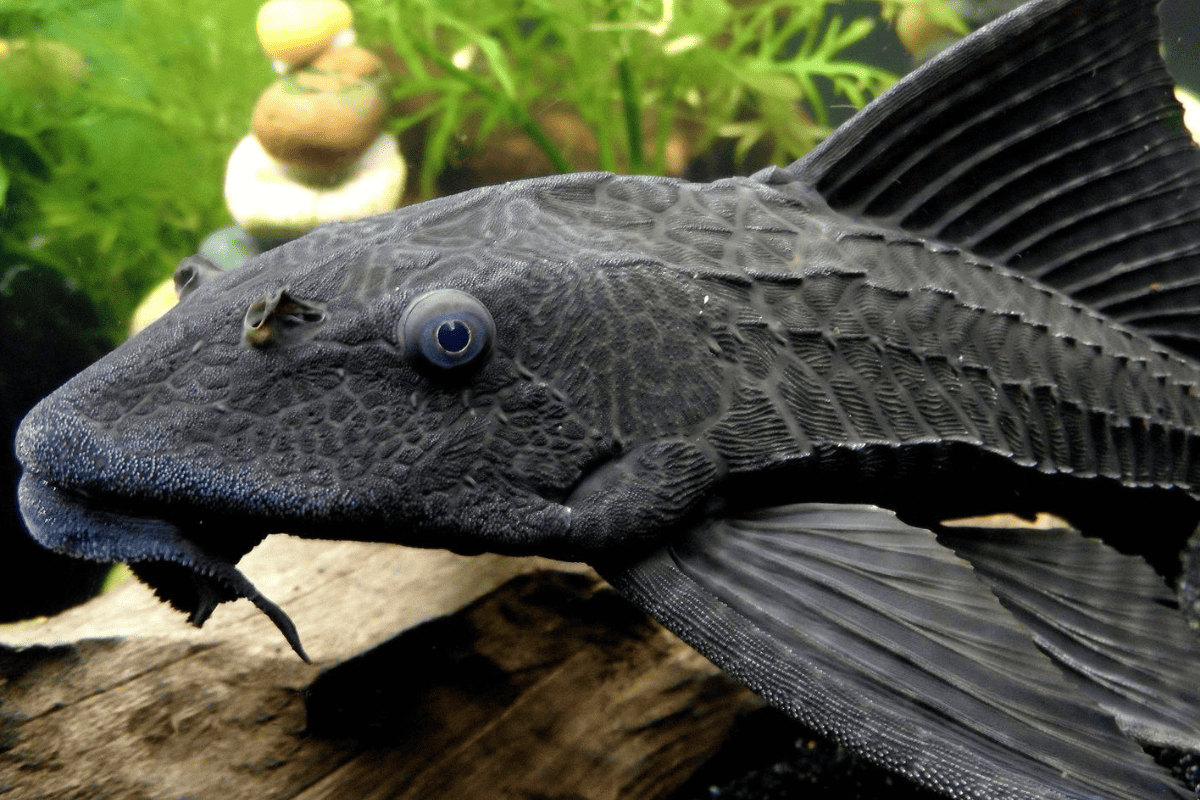
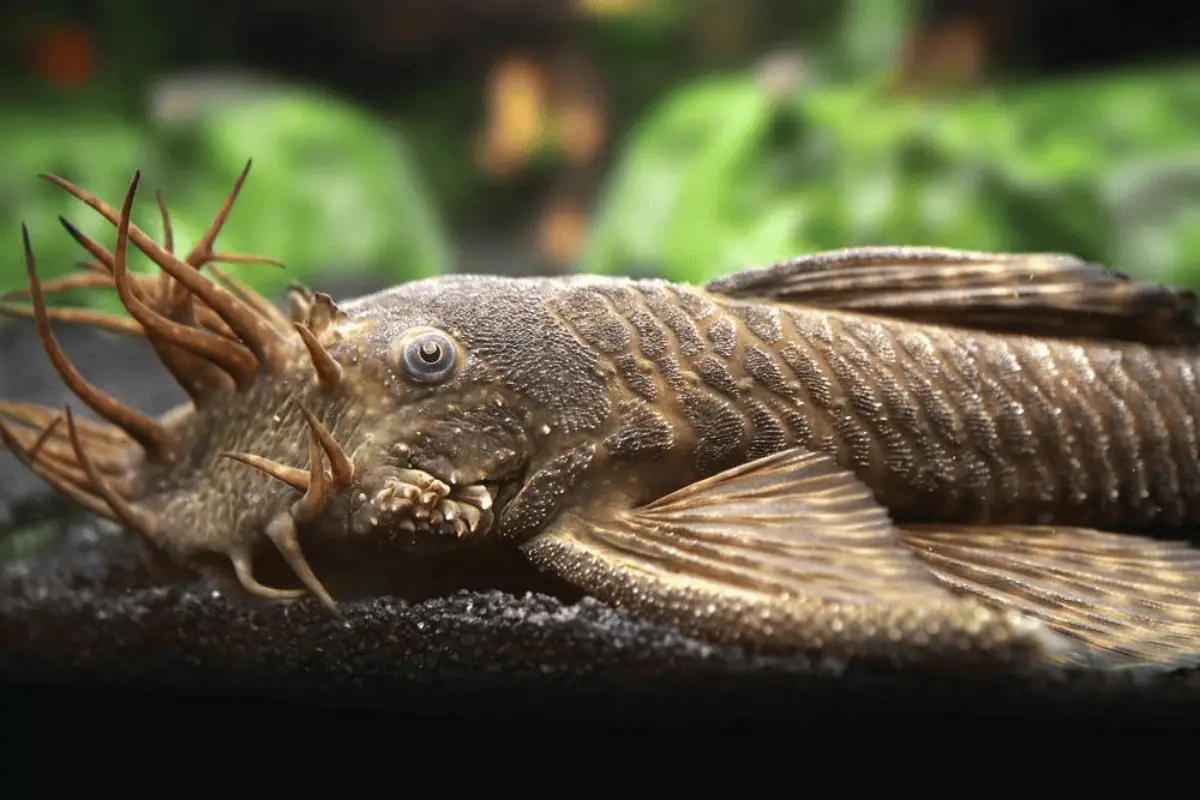
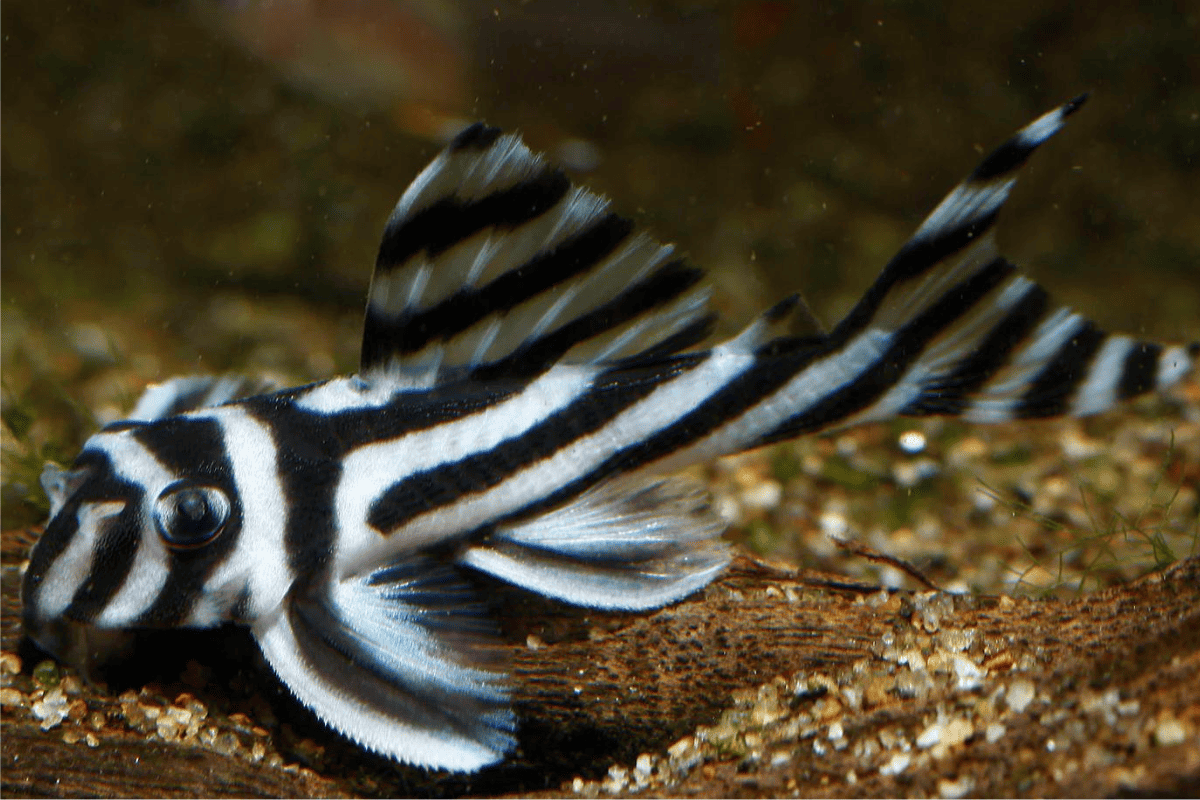
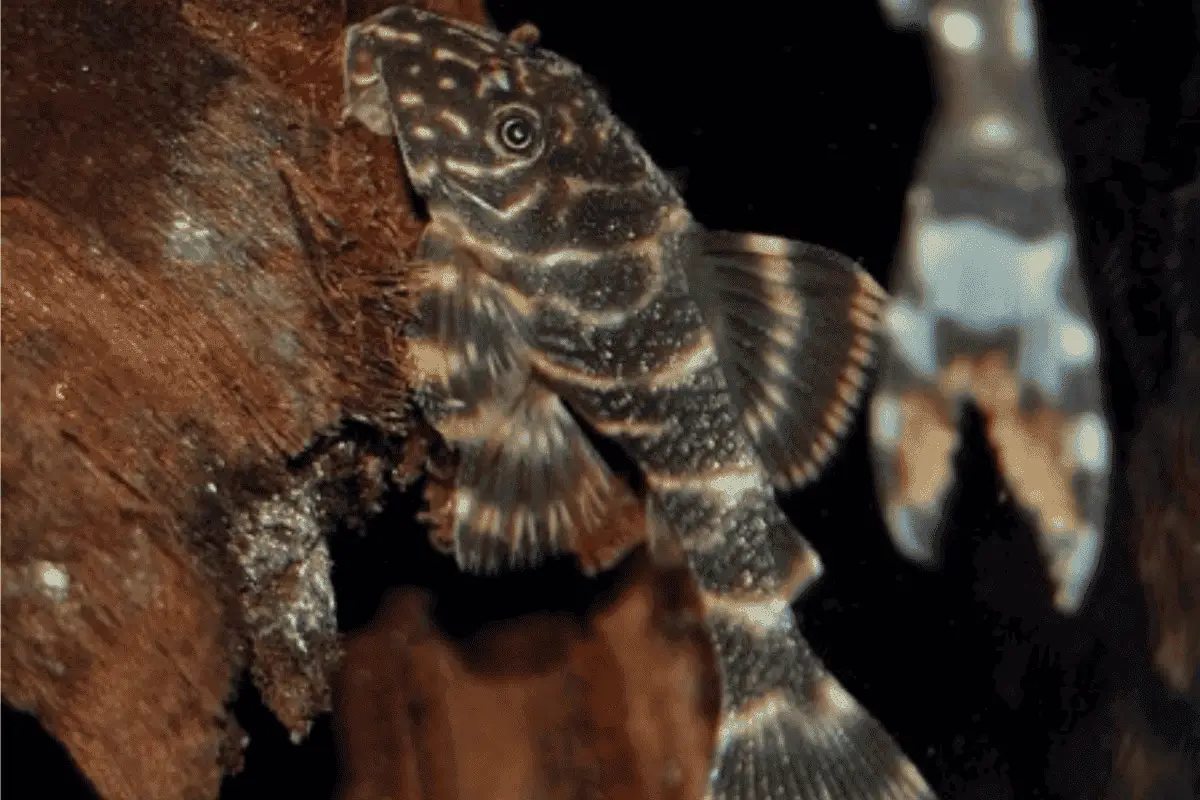



How to Care for Pleco Fish
Let’s begin with a thorough overview of how to properly care for Plecos, starting with their tank setup:
Pleco Fish Tank Setup
To get started, let’s ensure your Pleco fish tank is set up correctly:
1. Tank Size
Ensuring the right tank size for Plecos is pivotal for their well-being and to cater to their growth potential.
- Space Requirement: Common Plecos can reach 24 inches; a minimum 75-gallon tank is recommended.
- Bristlenose Plecos: Being smaller at 4-6 inches, they thrive in a 20-30 gallon tank setup.
- Room to Roam: Plecos enjoy spaces with driftwood and caves; ensure a tank layout that supports exploration.
- Avoid Overcrowding: Aim for 1 Pleco per 40 gallons, allowing each adequate territory and reducing stress.
Here’s a table of 20 Pleco species sorted by popularity, along with their recommended tank sizes:
| Pleco Species | Recommended Tank Size (Gallons) |
| Common Pleco (L021) | 100+ (can grow up to 2 feet) |
| Bristlenose Pleco (L144) | 20-30 |
| Clown Pleco (L104) | 20-30 |
| Rubber Lip Pleco (L187b) | 20-30 |
| Zebra Pleco (L046) | 30 |
| Royal Pleco (L190) | 125+ |
| Gold Nugget Pleco (L018) | 55+ |
| Snowball Pleco (L102) | 55 |
| Blue Phantom Pleco (L128) | 70+ |
| Green Phantom Pleco (L200) | 70+ |
| Vampire Pleco (L029) | 70 |
| Sunshine Pleco (L014) | 90+ |
| Sailfin Pleco (L83) | 125+ |
| Peppermint Pleco (L030) | 50+ |
| Medusa Pleco (L034) | 50 |
| Bulldog Pleco (L187) | 40 |
| Whiptail Pleco (L052) | 55+ |
| King Tiger Pleco (L066) | 50 |
| Candy Striped Pleco (L015) | 55+ |
| Butterfly Pleco (L052) | 40 |

2. Temperature
Plecos are tropical fish, and the tank temperature should reflect their natural habitat.
- Optimal Range: Maintain a water temperature between 74°F and 80°F for optimal Pleco health.
- Consistency is Key: Use heaters with thermostats to avoid temperature fluctuations, ensuring a stable environment.
- Regular Monitoring: Check the temperature daily using a reliable aquarium thermometer, adjusting as necessary.
- Avoid Rapid Changes: If adjustments are needed, change the temperature gradually, no more than 2°F per hour.
3. Water Acidity
The pH level in the water directly impacts Plecos’ health and is pivotal for their metabolic processes.
- Ideal pH Levels: Aim for a pH range of 6.5 to 7.5, which mimics their natural environment.
- Regular Testing: Use pH test kits weekly to monitor acidity and make necessary adjustments.
- Natural Adjusters: Introduce driftwood or peat to lower pH or crushed coral to raise it, naturally adjusting water acidity. My recommendation: Dr. Moss Malaysian Driftwood (link to Amazon).
- Chemical Balancers: If natural methods don’t suffice, utilize pH balancers from reputable brands, but always introduce gradually.

4. Ammonia, Nitrite, Nitrate
Maintaining water quality is essential, as spikes can stress and even harm Plecos.
- Zero Tolerance: Aim for 0 ppm (parts per million) ammonia and nitrite; these are toxic even at low levels.
- Nitrate Levels: Keep nitrate below 40 ppm, ideally between 5-20 ppm for the healthiest environment.
- Regular Testing: Utilize water test kits weekly to gauge these levels, ensuring early detection of issues. I found the API Freshwater Master Test Kit (link to Amazon) to be the most accurate.
- Water Changes: Perform 25-30% water changes weekly or if levels rise, to dilute harmful elements.
5. Heater
As tropical fish, Plecos need consistently warm water.
- Wattage Guidance: Use 3-5 watts per gallon; e.g., a 50-gallon tank needs a 150-250 watt heater.
- Placement Matters: Position the heater near a water flow source, like the filter outlet, for even heat distribution.
- Safety First: Opt for heaters with an auto shut-off feature to prevent overheating and potential tank disasters. I personally picked the Fluval E300 Advanced Heater (link to Amazon).
- Backup Plan: Keep a spare heater. In cold climates, heater malfunctions can quickly become fatal for tropical fish.

6. Air Pump, Bubbler
Oxygenating the water aids in Plecos’ respiration and overall tank health.
- Surface Agitation: An air pump increases water movement at the surface, promoting better gas exchange.
- Oxygen Boost: Bubblers enhance oxygen levels in water, essential for Plecos and beneficial bacteria.
- Backup During Power Outages: Battery-operated air pumps can be lifesavers during electrical interruptions, ensuring continued oxygenation.
- Noise Consideration: Opt for quieter models or place pumps on vibration-absorbing pads to reduce noise, ensuring a peaceful environment.
7. Filter
Filters help in maintaining clean and healthy water for your Plecos.
- Capacity Matters: Choose a filter rated for a tank size larger than yours; for a 50-gallon tank, a 70-80 gallon filter capacity is ideal.
- Multi-stage Filtration: Opt for filters offering mechanical, biological, and chemical filtration for comprehensive water purification. The Fluval C4 Power Filter (link to Amazon) would be an excellent starting point.
- Maintenance: Clean and replace filter media as recommended, typically every 3-4 weeks, to ensure optimal performance.
- Water Flow: Plecos enjoy moderate flow; adjust filter outputs to ensure no areas in the tank are stagnant.

8. Plants
Plants can offer shelter and enhance water quality, creating a natural habitat for Plecos.
- Hardy Plants: Choose robust plants like Anubias or Java Fern, as Plecos might sometimes nibble or disturb delicate species.
- Root Protection: Plant roots in pots or protect with stones, as Plecos might dig, potentially uprooting plants.
- Natural Benefits: Plants absorb nitrates and provide hiding spots, making Plecos feel more secure and less stressed.
- Avoid Overcrowding: Ensure plants don’t dominate the tank’s space, leaving ample room for Plecos to navigate and feed.
9. Light
Lighting is essential for the plants and to replicate a natural day-night cycle for Plecos.
- Moderate Lighting: Plecos are not fans of bright lights; opt for moderate light levels to keep them comfortable.
- LED Options: Choose LED lights as they produce less heat and offer customizable intensity and color settings.
- Natural Cycle: Maintain a consistent 10-12 hour light cycle, mimicking natural daylight patterns.
- Night-time Comfort: Consider moonlight or subdued blue LED modes for evenings, ensuring Plecos can forage in dimmed conditions.
10. Hiding Spots
Plecos cherish their privacy, so ensuring they have adequate and well-placed hiding spots is essential for their comfort.
- Driftwood: Besides being a natural grazing area, driftwood, when placed near corners, provides a shaded retreat for Plecos.
- Caves and PVC Pipes: These are perfect for Plecos who prefer seclusion. Consider placing some closer to the substrate for those who like being near the bottom. My Plecos absolutely love this Jabukosu Aquarium Cave (link to Amazon).
- Strategic Placement: While ensuring hiding spots, also think of their proximity to feeding areas, allowing Plecos an easy transition from eating to resting.
- Multi-Pleco Consideration: For tanks with several Plecos, ensure hiding areas are spread out to avoid territorial disputes.
Also Read: Pleco Fish Tank Setup

How to Feed Pleco Fish
When feeding Plecos, it’s essential to take into account three crucial factors: the food type, the quantity, and the frequency of feeding:
1. What do Plecos Eat?
Plecos are omnivorous scavengers, predominantly leaning towards plant matter and algae.
Their dietary preferences in the wild can be diverse, necessitating a well-rounded intake in captivity.
- Algae and Plants: Plecos thrive on algae; feeding 1-2 algae wafers weekly ensures they have ample greens. My recommendation: Invert Aquatics Mini Algae Discs (link to Amazon).
- High-quality Pellets: Plecos benefit from sinking pellets. Offer 1 pellet per 2-3 inches of their length daily.
- Vegetable Matter: Offer slices of zucchini, cucumber, or spinach 1-2 times a week. Anchor them with a weight.
- Occasional Proteins: Plecos occasionally crave proteins. Provide a few bloodworms or brine shrimp bi-weekly.

2. How Much do Pleco Fish Eat?
The consumption rate for Plecos is influenced by factors like size and age. Young Plecos often consume proportionately more due to growth spurts.
- Monitor Their Size: A 6-inch Pleco might eat 2-3 algae wafers a day, while a smaller one might eat just 1.
- Adjust with Growth: As Plecos grow, incrementally increase their food by 25% for every 2-inch growth.
- Avoid Overfeeding: Plecos have a hearty appetite, but overfeeding can pollute the tank. Remove uneaten food after 24 hours.
- Diversify the Diet: Just as in the wild, variety is vital. Rotate food types throughout the week for balanced nutrition.
3. How Often do Plecos Eat?
Plecos are continuous grazers, often nibbling throughout the day and night, but structured feeding helps maintain tank cleanliness.
- Daily Feeding: Offer sinking pellets and algae wafers once daily, preferably during the evening.
- Vegetable Treats: Fresh vegetable slices can be introduced every other day but remove after 24 hours to prevent rot.
- Protein Intervals: Provide protein treats like bloodworms once every 1-2 weeks for added nutrition.
- Monitor Behavior: If Plecos are constantly searching for food, it may be a sign to slightly adjust feeding frequency or quantity.
Also Read: How To Feed Plecos

How to Pick Tank Mates For Plecos
Choosing suitable tank mates for Plecos requires a focus on peaceful species that don’t compete for the same resources.
Additionally, ensure the chosen species can thrive in similar water conditions as Plecos.
- Temperament Match: Plecos are generally peaceful. Opt for species like tetras or gouramis that also have a calm demeanor.
- Avoid Bottom Dwellers: Plecos spend much time at the bottom. Limit other bottom-feeders like corydoras to avoid resource competition.
- Similar Environment Needs: Ensure chosen tank mates prefer water pH of 6.5-7.5 and temperatures of 22-30°C, aligning with Pleco’s preferences.
- Space Consideration: Plecos can grow large. In tanks of less than 100 gallons, avoid big species like cichlids that need ample space.
For instance, here are some fish that can coexist with Plecos:
- Neon Tetra (Paracheirodon innesi)
- Gourami (Trichopodus trichopterus)
- Rasbora (Rasbora heteromorpha)
- Angelfish (Pterophyllum scalare)
- Platies (Xiphophorus maculatus)
- Mollies (Poecilia sphenops)
- Harlequin Rasbora (Trigonostigma heteromorpha)
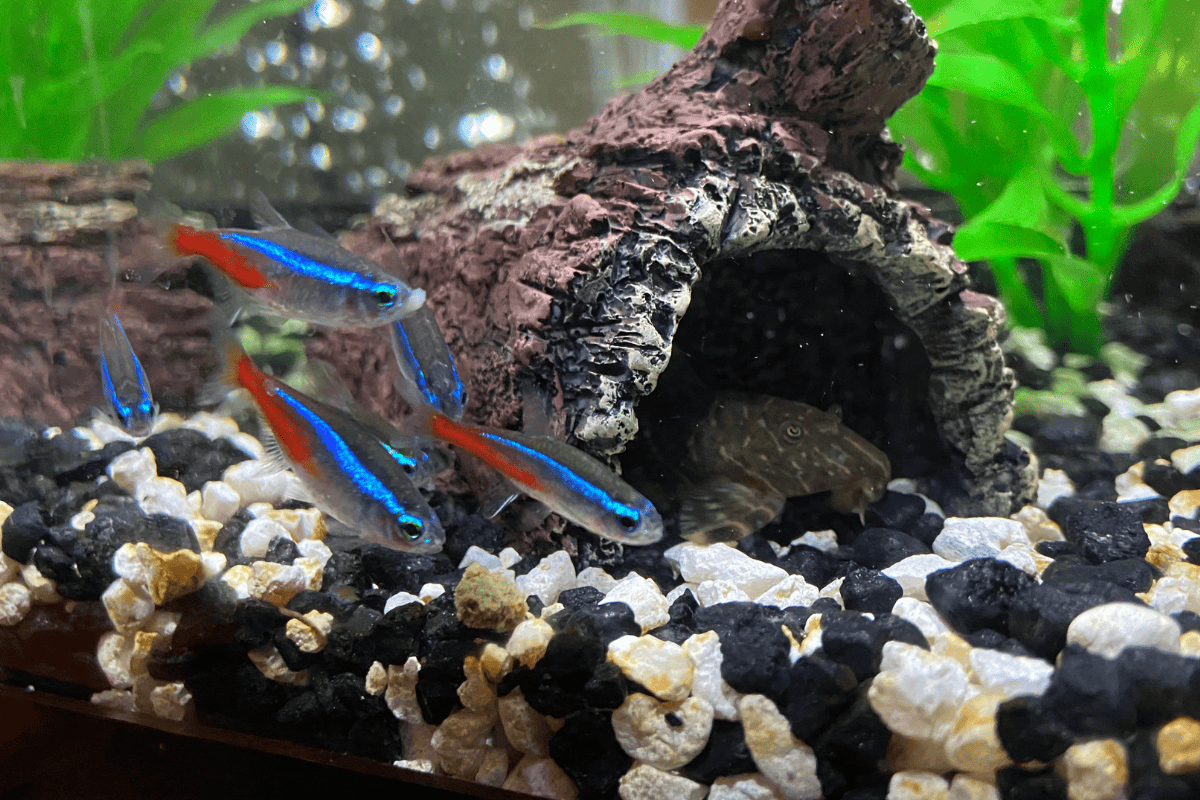
On the other hand, I would avoid species like:
- Oscar (Astronotus ocellatus)
- Jack Dempsey (Rocio octofasciata)
- African Cichlids (Cichlidae)
- Discus (Symphysodon spp.)
- Red-Tailed Black Shark (Epalzeorhynchos bicolor)
- Goldfish (Carassius auratus)
- Flowerhorn Cichlid (Cichlasoma spp.)
Also Read: Pleco Fish Tank Mates

How To Breed Pleco Fish
Breeding Plecos is a rewarding challenge, requiring specific conditions and patience.
Achieving successful Pleco breeding involves simulating their natural habitat and monitoring behavior closely.
- Tank Requirements: Start with a minimum 55-gallon tank to give Plecos ample space. A larger setup enhances breeding success.
- Create Caves: Plecos prefer secluded spots for laying eggs. Use PVC pipes or terracotta pots to simulate natural caves.
- Water Parameters: Maintain a pH of 6.5-7.5 and temperature of 28-30°C. This mimics the conditions of Pleco breeding habitats.
- Diet Enhancement: Before breeding, offer a richer diet of bloodworms and vegetables. This helps Plecos attain prime breeding condition.
- Initiate Breeding: Simulate rain by changing 25% of the tank water with cooler water. This change triggers Plecos’ breeding instincts.
- Monitor Behavior: Males will guard caves, attracting females. Check for frequent cave visits by females as a sign of spawning.
- Protect the Eggs: Once eggs are laid, the male guards them. Avoid disturbing the area and be prepared for fry emergence in about 10 days.
Also Read: Breeding Pleco Fish

Caring for Pleco Fish Eggs
Taking care of Pleco eggs is crucial to ensure successful hatching and the wellbeing of the fry.
Ensuring the right conditions and vigilantly monitoring the eggs will optimize their chances of developing fully.
- Disturbance Minimization: Plecos are protective parents. Limit tank activity and movements around their nesting area to reduce stress.
- Optimal Water Conditions: Maintaining consistent water parameters with a pH of 6.5-7.5 and temperatures around 28-30°C ensures egg viability.
- Filtration Caution: Eggs can be sucked into filters. Use a sponge filter or cover intake tubes to prevent this risk. An affordable choice would be the Pawfly Nano Bio Sponge Filter (link to Amazon).
- Monitor for Fungus: Fertilized eggs are translucent, while unfertilized ones turn white and might get fungal. Remove white eggs to prevent fungus spread.
- Prepare for Hatching: Pleco eggs hatch in roughly 7-10 days. Set up a separate tank or partition to protect and raise the delicate fry.
Also Read: Pleco Fish Eggs

How to Raise Pleco Fish Fry
Raising Pleco fry is an engaging journey that demands special attention to their dietary and environmental needs.
By offering the right nutrients and maintaining optimal conditions, young Plecos can thrive and grow healthily.
- Separate Tank: Set up a specific nursery tank of at least 20 gallons. This isolates the fry, safeguarding them from larger tankmates.
- Water Conditions: Aim for steady water parameters, keeping pH at 6.5-7.5 and temperatures around 28-30°C for fry health.
- Gentle Filtration: High currents can be harmful. Use sponge filters as they create a mild flow and are fry-safe.
- Nutritious Diet: Begin feeding with infusoria or liquid fry food for the first few days, then gradually introduce crushed flakes and micro-worms. My recommendation: Northfin Fry Starter (link to Amazon).
- Regular Monitoring: Check on Pleco fry often. Look for active swimming and steady growth as signs of healthy development.
- Gradual Transition: As they grow, slowly introduce them to the main tank over weeks, ensuring they’ve reached a size safe from potential predators.
Also Read: Pleco Fry Care

Common Pleco Fish Diseases
Like all other fish, Plecos can be vulnerable to various illnesses. Let’s focus on some of the most common ones:
1. Hole in the Head (HITH)
HITH affects Plecos, leading to noticeable pits on their head and body. Environmental and dietary factors often play a role.
- Causes: Primarily from poor water quality (high nitrates) and dietary deficiencies, particularly in vitamins.
- Symptoms: Plecos showcase holes on the head and along the lateral line, often coupled with lethargy and loss of appetite.
- Treatment: Combine metronidazole-based treatments with a vitamin-rich diet and frequent water changes of about 25%.
- Prognosis: Detected early, Plecos can recover within weeks; however, some scars might persist.

2. Ich (Ichthyophthirius multifiliis)
Ich appears as salt-like white spots on Plecos, caused by a microscopic parasite.
- Causes: Mainly from introducing infected fish or equipment without quarantine, with stress amplifying susceptibility.
- Symptoms: Plecos present numerous white spots, rapid gill movement, and often scrape against tank surfaces.
- Treatment: Gradually raise tank temperature to 30°C (86°F) over 24 hours and apply copper-based medications for 7-10 days. My recommendation: Fritz Mardel Coppersafe (link to Amazon).
- Prognosis: With prompt treatment, Plecos can fully recover in 2-3 weeks, especially if addressed at early stages.

3. Fin Rot
Fin Rot affects Plecos’ fins, making them appear tattered and discolored due to bacterial or fungal agents.
- Causes: Often stems from poor water conditions, injuries, or a compromised immune system from stress or other illnesses.
- Symptoms: Plecos display fins with frayed, discolored edges, often with a milky or white edge appearance.
- Treatment: Improve water quality through 50% water changes and administer broad-spectrum antibiotics or antifungal treatments. A good starting point would be utilizing the Seachem PolyGuard (link to Amazon).
- Prognosis: With consistent treatment, Plecos can see fin regrowth in weeks, but severe cases might lead to permanent fin loss.

4. Swim Bladder Disease
Swim Bladder Disease can hinder Plecos’ ability to maintain their buoyancy, often resulting in irregular swimming patterns.
It’s usually caused by various factors like diet, infections, or injuries.
- Causes: The condition can arise from overfeeding, constipation, bacterial infections, or physical injuries.
- Symptoms: Plecos may float upside down, struggle to maintain a steady position, or sink to the bottom more than usual.
- Treatment: Initial steps include fasting the fish for 48 hours followed by feeding shelled peas, combined with gradual water changes of 25%.
- Prognosis: If addressed promptly, most Plecos can regain normal swimming patterns in a week or two, but severe cases might need more extended care.

5. Popeye Disease
Popeye Disease causes one or both eyes of Plecos to protrude, often indicating an underlying bacterial infection or injury.
- Causes: It’s typically attributed to internal infections, injuries, or extremely poor water conditions leading to a buildup of fluid in the eye.
- Symptoms: Plecos with Popeye will exhibit bulging eyes that may have a cloudy appearance, and sometimes associated lethargy.
- Treatment: Regular 50% water changes, combined with broad-spectrum antibiotics, are recommended to address underlying causes.
- Prognosis: With timely treatment, Plecos can recover within weeks, but in severe cases, the eye might not fully retract.
Also Read: Pleco Fish Diseases

Identifying And Treating Stressed Plecos
Recognizing signs of stress in Plecos is pivotal for their well-being, as prolonged stress can lead to health complications.
An astute observer can pick up on subtle changes in a Pleco’s behavior and appearance that hint at distress.
- Erratic Swimming: Stressed Plecos often exhibit unusual swimming patterns, darting rapidly or floating listlessly near the surface.
- Color Changes: Plecos under stress may display paler colors or sudden darkening, especially if they feel threatened or unwell.
- Loss of Appetite: A stressed Pleco might refrain from eating for extended periods, ignoring even their favorite foods.
- Hiding Excessively: While Plecos are naturally reclusive, overly prolonged hiding or reluctance to come out even at night indicates stress.
- Rapid Breathing: Monitor their gills; increased gill movement or gasping at the water’s surface suggests distress or poor water conditions.

Here are some methods to help alleviate stress in Plecos:
Addressing stress in Plecos promptly is crucial for their long-term health and comfort.
Through adjustments in their environment and care routines, one can alleviate the factors causing distress and return Plecos to a state of ease.
- Water Quality Check: Ensure optimal water parameters; for Plecos, this means a pH of 6.5-7.5 and temperatures of 26-30°C. Regularly test and adjust as necessary.
- Reduce Tank Traffic: Minimize disturbances by limiting sudden movements around the tank and reducing the number of aggressive tank mates.
- Provide Hiding Spots: Enhance their environment with caves, driftwood, or plants where Plecos can seek refuge. For example, a hollowed log or dense plant clusters.
- Maintain a Routine: Keep a consistent light-dark cycle and feeding schedule. For instance, lights on for 10 hours, then off for 14 hours daily.
- Dietary Review: Ensure a balanced diet; introduce vitamin-rich foods like spirulina wafers or blanched veggies like zucchini slices.
Also Read: Stress In Pleco Fish

Conclusions
For those of you who are just skimming through, here’s a short recap:
- Plecos are diverse and resilient freshwater aquarium fish known for their algae-cleaning abilities and unique appearances, originating from South America.
- Proper care involves ensuring the right tank size, temperature, water quality, and equipment for these fish, along with providing a balanced diet that includes algae, pellets, vegetables, and occasional proteins.
- Selecting compatible tank mates is crucial, favoring peaceful species that share similar water conditions and space requirements while avoiding aggressive or incompatible ones.
- Breeding Plecos requires specific conditions like caves, optimal water parameters, and patience, and raising fry involves a separate tank and special care.
- Common diseases, such as Hole in the Head, Ich, Fin Rot, Swim Bladder Disease, and Popeye Disease, can affect Plecos, and recognizing and addressing these issues promptly is crucial for their well-being.
